Homicide: Classification and Understanding the Different Degrees
Introduction
Homicide is a legal term used to describe the act of unlawfully causing the death of another person. It is a serious offense that is classified into different degrees based on the circumstances and intent of the perpetrator. Understanding the different degrees of homicide is essential for both legal professionals and the general public.
First Degree Homicide
First-degree homicide, also known as murder, is the most severe form of homicide. It involves the intentional and premeditated killing of another person with malice aforethought. Malice aforethought refers to the deliberate intention to cause death or serious bodily harm. To prove first-degree homicide, the prosecution must demonstrate the presence of premeditation and malice aforethought beyond a reasonable doubt.
Second Degree Homicide
Second-degree homicide, commonly referred to as voluntary manslaughter, is a lesser offense compared to first-degree homicide. It involves the intentional killing of another person, but without premeditation or malice aforethought. The key distinction between first and second-degree homicide is the absence of premeditation. Second-degree homicide is often characterized by a sudden heat of passion or the absence of full mental capacity at the time of the killing.
Third Degree Homicide
Third-degree homicide, also known as involuntary manslaughter, is the least severe form of homicide. It refers to the unintentional killing of another person as a result of reckless or negligent behavior. Unlike first and second-degree homicide, third-degree homicide lacks the element of intent. However, the person responsible for the death still acted in a manner that endangered the lives of others, leading to the fatal outcome.
Closing Thoughts
Understanding the different degrees of homicide is crucial in the field of criminal law. Whether you’re preparing for your SQE 1 or SQE 2 exams or simply looking to expand your knowledge, having a comprehensive understanding of the classification of homicide is essential. If you’re interested in practicing exam questions to enhance your understanding, consider checking out our articles on SQE 1 Practice Exam Questions. We also offer preparation courses to help you excel in your legal studies.
For more information about the SRA SQE exam dates, please refer to our article on SRA SQE Exam Dates. We are here to support you on your journey towards becoming a successful legal professional.
